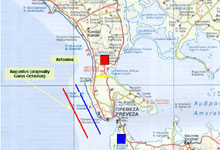 |
The battle of Actium: Squares depict the camps of
the two rivals. It was Augusuts that founded Nikopolis.
(Map © Epirus-Thessalia published by Road publishers) |
Greece, during the Roman dominance in the Mediterranean, has been the theatre
for numerous battles between Consuls and Generals. Nikopolis, in particular,
is a location where one of the most decisive of those battles took place.
On the Western side of the Gulf of Amvrakikos, two peninsulas are divided
by only one narrow strait of sea (of approximately 500 kilometers), which
is actually the entrance of the Gulf itself. Almost on the edge of the
southern peninsula was the city of Actium after which the famous naval
battle was named; the outcome of this naval battle transformed the Roman
system of Government (from democracy to empire).
On the opposite ends of
the peninsulas camped the troops: Augustus (originally Gaius Octavius)
on the northern end, close to where Nikopolis is today, and, on the southern
end, close to Actium, Marcus Antonius and Cleopatra. In September 31 B.C.,
the two fleets where lined up on the Ionian Sea; Augustus had gathered
400 ships and Antonius 230.
 |
| The naval battle between the fleets of Augustus
and Antonius and Cleopatra took place here in 31 B.C. The Castle
of Pantokratoras (from which this picture was taken) was built in
1804 by Ali Pasa, the Ottoman ruler of Ioannina, who wished to control
ships entering the Gulf. It was this sea route that was used in order
to carry provisions to the city of Ioannina. It is also here that
a fleet of ships of Christians gathered in 1538 to battle against
Khayradin Barbarossa, the Admiral-pirate of the Ottoman Empire, who
was defeated. |
Soon, victory was on the side of Augustus,
mainly after the mutiny of crews from ships ordered by Antonius, and thus
Antonius and Cleopatra found refugee in Egypt where they eventually committed
suicide. It was then that Augustus, who had finally triumphed, was proclaimed
emperor.
Augustus, aiming to keep western Greece under his control, founded Nikopolis,
the City of Victory (“Nike” = Victory in Greek). People coming from many
cities of western Greece were forced to live here, especially from areas
northern of Epirus, and south of Akarnania and parts of Aetolia. From Epirus,
for example, in that horrific period, 150.000 people were sold to slavery,
thousands were slaughtered and more than 70 cities were destroyed.
The most important works of art were looted from other areas and transferred
to the new-found city, thus making Nikopolis a Greek city in terms of social
mores and customs and Roman in status.
It was fortified with a wall which
extended 5 kilometers, while its gigantic aqueduct (approximately 40 kilometers
in length) brought water to the city directly from Louros river. During
the Byzantine period, the length of the surrounding wall was shortened
in order to re-organize defense against barbaric raids.
 |
| Panoramic map of the Gulf of Amvrakikos showing
ancient Kassopi (blue arrow) on the northern of Nikopolis and the
location where the battle of Actium took place (yellow line). |
Nikopolis was one of the centres of Greek civilization and, at the same
time, a hub between East and West. The decline of the Roman Empire in the
3rd century A.D. affected equally the city, which gradually lost its grandeur
and international character. Adding to this, the barbaric raids that ensued
in the next centuries sank the city into oblivion until in the 5ht century
it was re-born as the centre of Christianity in western Greece.
A new era
of prosperity started for the city, to which the numerous newly-built buildings
and the 6 basilicas attest to. This era was halted when the Byzantine state
was re-organised to “Themata”, and thus, for “thema” of Nikopolis, Naupaktos
was proclaimed capital city, rather than Nikopolis itself. And so Nikopolis
was deserted and its inhabitants moved to Preveza, which is a city laying
right on the sea.
 |
 |
| Part of the archs from the Roman aqueduct
on Louros river, 30 kilometer NE of Nikopolis. |
| |
The Monument of Augustus
Augustus, after his victory and the founding of Nikopolis, built a temple
to honour the god Apollo on the hilltop, right above a village that stands
to this day and bears his name. At this temple he offered the prizes of
his victory to the gods Neptune and Mars.
 |
 |
| The entrance to the hill... |
...and the area of the Monument of Augustus (only the groundwork survives today) |
| |
 |
| The beaks of the enemies’ ships (Antonius and Cleopatra)
are in front of the monument as offerings to the gods of Neptune
and Mars. |
| |